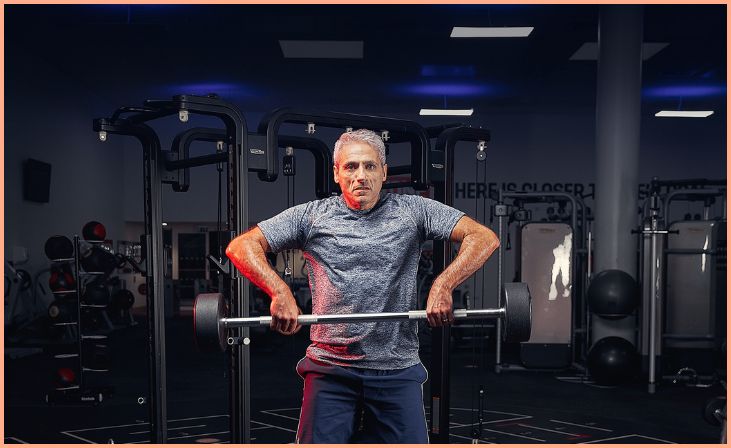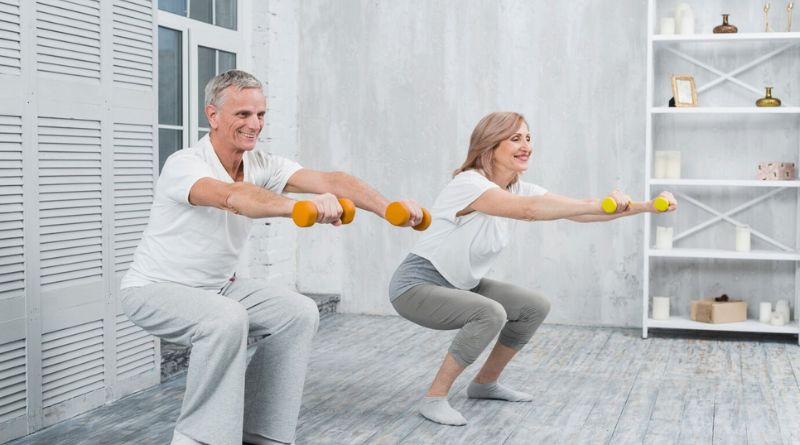Exercises for Total-Body Muscle Building – As we gracefully age, maintaining a robust physique becomes an essential part of our overall well-being. With the right exercise regimen, you can fortify your muscles, foster vitality, and enhance your quality of life. In this comprehensive guide, we delve into the five best exercises for total-body muscle building, tailored to meet the unique needs of individuals as they age.
5 Best Exercises for Total-Body Muscle Building as You Age
Squats

Squats are a fundamental compound exercise that targets multiple muscle groups simultaneously, making them an excellent choice for total-body muscle building. As you age, maintaining lower body strength becomes crucial for mobility and balance. Squats engage the quadriceps, hamstrings, glutes, and even the core, promoting functional strength and stability.
To perform a squat, stand with your feet shoulder-width apart, lower your body by bending your knees and hips, keeping your back straight, and ensuring your knees do not extend beyond your toes. Engage your core throughout the movement and return to the starting position. Incorporating squats into your routine helps maintain lower body muscle mass and joint flexibility, contributing to overall physical resilience and agility.
Also Read: Balance Exercises for Seniors
Push-Ups
Push-ups are a timeless exercise that targets the chest, shoulders, triceps, and core muscles, providing a comprehensive upper-body workout. As you age, maintaining upper body strength is vital for daily activities and posture support. Performing push-ups not only helps build muscle but also enhances shoulder stability and promotes bone health.
To execute a push-up, start in a plank position with your hands shoulder-width apart, lower your body by bending your elbows while maintaining a straight back, and push back up to the initial position. Regular inclusion of push-ups in your exercise regimen contributes to improved upper body strength, aiding in the preservation of functional independence and vitality.
Deadlifts

Deadlifts are a powerhouse exercise that targets the posterior chain, including the glutes, hamstrings, and lower back, fostering overall strength and stability. As you age, preserving a strong posterior chain is essential for maintaining proper posture and preventing lower back pain. Performing deadlifts helps improve hip mobility, enhances grip strength, and fortifies the muscles responsible for supporting the spine.
To execute a deadlift, stand with your feet hip-width apart, grasp the barbell with an overhand grip, keeping your back straight, and lift the barbell by extending your hips and knees. Be careful as you lower the heavy back to the ground. Incorporating deadlifts into your routine contributes to a robust posterior chain, facilitating better movement mechanics and reducing the risk of age-related muscular imbalances.
Pull-Ups
Pull-ups are a dynamic exercise that primarily targets the back, biceps, and forearms, promoting overall upper body strength and muscular endurance. As you age, maintaining a strong back is crucial for proper posture and spinal support. Incorporating pull-ups into your workout routine not only aids in building a strong and defined back but also contributes to improved grip strength and shoulder stability.
To perform a pull-up, grip the bar with your palms facing away, engage your core, and pull your body up until your chin is above the bar. Lower your body back down with control. Regular practice of pull-ups enhances back strength and stability, fostering better posture and reducing the risk of age-related back problems.
Lunges

Lunges are a versatile lower body exercise that targets the quadriceps, hamstrings, glutes, and calf muscles, promoting balanced lower body strength and stability. As you age, maintaining lower body mobility and muscle function is vital for preserving independence and preventing falls. Lunges not only help strengthen the lower body but also improve hip flexibility and balance.
To perform a lunge, step forward with one leg, lower your body until both knees are bent at a 90-degree angle, and then push back to the starting position. Incorporating lunges into your routine enhances lower body strength and stability, fostering better mobility and reducing the risk of age-related mobility limitations.
Also Read: Best Yoga Poses For Individuals
5 Health Benefits Of Doing Exercise as You Age
Enhanced Muscle Strength and Mass

Engaging in regular exercise as you age contributes to the preservation and development of muscle strength and mass. Strength training exercises, in particular, promote the growth of muscle fibers, which can help counteract the natural muscle loss that occurs with aging, ultimately enhancing overall physical resilience and functional independence.
Improved Bone Health
Exercise plays a pivotal role in maintaining and improving bone density, reducing the risk of osteoporosis and fractures, common concerns among the aging population. Weight-bearing exercises such as walking, jogging, and resistance training stimulate bone formation, contributing to stronger, healthier bones and reducing the likelihood of bone-related injuries.
Enhanced Cardiovascular Health
Regular physical activity helps improve cardiovascular health by strengthening the heart muscle, reducing blood pressure, and improving blood circulation. Engaging in aerobic exercises such as brisk walking, swimming, or cycling can help lower the risk of cardiovascular diseases, including heart attacks, strokes, and coronary artery disease, thus promoting overall heart health as you age.
Enhanced Mental Well-being
Exercise has a profound impact on mental well-being, helping to alleviate stress, anxiety, and depression commonly associated with aging. Physical activity stimulates the production of endorphins, the body’s natural mood elevators, promoting a sense of well-being and reducing the risk of cognitive decline. Regular exercise also fosters improved cognitive function, enhancing memory, focus, and overall mental acuity.
Better Quality of Sleep

Engaging in regular physical activity as you age can significantly improve the quality and duration of your sleep. The body’s circadian rhythm is better controlled by exercise, which makes the sleep-wake period more stable. Moreover, the release of endorphins during exercise contributes to reduced stress and anxiety, facilitating a more relaxed state conducive to better sleep quality. By establishing a consistent exercise routine, you can experience improved sleep patterns and overall restorative rest, contributing to better overall health and well-being.
Also Read: Effective Workouts for a Healthy Lifestyle
Conclusion
In the journey of graceful aging, prioritizing muscle building exercises can be a game-changer, fostering resilience and strength that transcends the passing years. By incorporating these five fundamental exercises into your routine, you can relish an active, fulfilling lifestyle while reaping the manifold benefits of a robust and agile body. Embrace the power of movement and embark on a path to rejuvenation, vitality, and lasting wellness.
FAQs
Yes, these exercises are beginner-friendly and can be adapted to various fitness levels. Start with light weights or resistance bands, focus on proper form, and gradually increase intensity as your strength improves. Always consult a fitness professional to ensure you’re using the correct techniques and modifications suitable for your fitness level.
These exercises are suitable for individuals of all age groups, but they particularly cater to those over 40, aiming to maintain or regain muscle mass, bone density, and overall strength. The exercises are versatile and adaptable, making them accessible to people in their middle-aged and senior years who want to enhance their physical well-being and quality of life.







